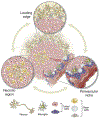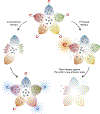Glioblastoma Stem Cells: Driving Resilience through Chaos
- PMID: 32101725
- PMCID: PMC8779821
- DOI: 10.1016/j.trecan.2020.01.009
Glioblastoma Stem Cells: Driving Resilience through Chaos
Abstract
Glioblastoma is an aggressive and heterogeneous tumor in which glioblastoma stem cells (GSCs) are at the apex of an entropic hierarchy and impart devastating therapy resistance. The high entropy of GSCs is driven by a permissive epigenetic landscape and a mutational landscape that revokes crucial cellular checkpoints. The GSC population encompasses a complex array of diverse microstates that are defined and maintained by a wide variety of attractors including the complex tumor ecosystem and therapeutic intervention. Constant dynamic transcriptional fluctuations result in a highly adaptable and heterogeneous entity primed for therapy evasion and survival. Analyzing the transcriptional, epigenetic, and metabolic landscapes of GSC dynamics in the context of a stochastically fluctuating tumor network will provide novel strategies to target resistant populations of GSCs in glioblastoma.
Keywords: cancer stem cell; entropy; glioblastoma; heterogeneity; therapy resistance; tumor evolution.
Copyright © 2020 Elsevier Inc. All rights reserved.
Figures



References
-
- Stupp R, Mason WP, van den Bent MJ, Weller M, Fisher B, Taphoorn MJB, et al. Radiotherapy plus Concomitant and Adjuvant Temozolomide for Glioblastoma. N Engl J Med. 2005. Mar 10;352(10):987–96. - PubMed
-
- Omuro A. Glioblastoma and Other Malignant Gliomas: A Clinical Review. JAMA. 2013. Nov 6;310(17):1842. - PubMed
-
- Hanahan D, Weinberg RA. Hallmarks of Cancer: The Next Generation. Cell. 2011. Mar;144(5):646–74. - PubMed
Publication types
MeSH terms
Substances
Grants and funding
LinkOut - more resources
Full Text Sources
Other Literature Sources
Medical
Research Materials
Miscellaneous

